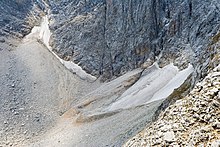Snezhnika
Snezhnika's size varies in length from 70 to 100 metres (west to east) and in width from 40 to 90 metres (north to south). Its firn is 8–11 m thick at the base and its snow cover, which is mostly fed by avalanche snow, can be as deep as 20 metres in March and April. Snezhnika's latitude of 41°46′09″ N makes it the southernmost glacial mass in Europe; the nearby Banski Suhodol Glacier below Koncheto, although larger, is slightly to the north.

Snezhnika lies in an east-facing hollow adjacent to the almost vertical north wall of Vihren and is surrounded on three sides by a moraine or moraine-like rock debris. The north wall of Vihren supplies Snezhnika with avalanche snow. The strong shade of the high vertical wall and the high albedo of its white marble as well as the karstified bottom of the hollow provide suitable conditions for glaciation.
Snezhnika has existed continuously since at least the Little Ice Age, when it presumably reached a maximum area of 0.93 hectares, and its age is estimated at more than 500 years. While its size varies greatly from year to year, it has remained relatively stable from the mid-20th to the 21st century, despite low precipitation and a relatively high and increasing annual mean temperature. Snezhnika exhibits less variability in size than the glaciers and glacierets of Albania (below Maja Jezercë) and Montenegro (Debeli Namet), which lie at a lower altitude and rely on heavier precipitation. Otherwise, Snezhnika has a very comparable topography to these and to the Calderone glacier of the Apennines.
The presence of perennial snow in Pirin has been documented since the 1920s. The first in-depth study of Snezhnika dates to 1957–61 and was conducted by Vladimir Popov of the Bulgarian Academy of Sciences's Institute of Geography. Further research was done by a team under Karsten Grunewald of the Landscape Research Centre in Dresden, Germany, from 1994 to 2007.
Footnotes
- ^ Grunewald, Karsten; Jörg Scheithauer (2010). "Europe's southernmost glaciers: response and adaptation to climate change". Journal of Glaciology. 56 (195). International Glaciological Society: 129–142. Bibcode:2010JGlac..56..129G. doi:10.3189/002214310791190947. ISSN 0022-1430.
- ^ Grunewald, p. 129.
- ^ "(the pirin mountains, bulgaria) in the last ten years" (PDF). igipz.pan.pl. Retrieved 5 February 2014.
- ^ Ganchev et al. (2009), p. 18.
- ^ "List of Ultra Prominent Peaks of Europe". Ultra Prominent Peaks. Retrieved 16 December 2017.
- ^ Gachev (2011), p. 49.
- ^ Gachev et al. (2009), p. 17.
- ^ Grunewald, p. 132.
- ^ Gachev (2011), p. 51.
- ^ Grunewald, K; Scheithauer, J (2010), "Europe's southernmost glaciers: response and adaptation to climate change", Journal of Glaciology, 56 (195): 129–142, Bibcode:2010JGlac..56..129G, doi:10.3189/002214310791190947
- ^ Emil Gachev; Alexander Gikov; Cvetelina Zlatinova; Bozidar Blagoev. "Present state of Bulgarian glacierets" (PDF). Landform Analysis. 11: 16–24. Archived from the original (PDF) on 2016-03-04.
- ^ "Съвременни снежно-фирнови тела в планината проклетия (албански алпи)" [Modern snow-firn bodies in Mount Prokletia (Albanian Alps)] (PDF) (in Bulgarian). Archived from the original (PDF) on 2019-07-11.
- ^ Gachev (2011), pp. 50–51.
- ^ Gachev (2011), p. 52.
- ^ Gachev (2011), p. 66.
- ^ Grunewald, p. 133.
- ^ Gachev (2011), pp. 48–49.
- ^ Gachev et al. (2009), p. 18.
References
- Gachev, Emil (2011). "Inter-annual size variations of Snezhnika Glacieret (the Pirin Mountains, Bulgaria) in the last ten years" (PDF). Studia Geomorphologica Carpatho-Balcanica. XLV. Polish Academy of Sciences: 47–68. ISSN 0081-6434. Retrieved 6 March 2015.
- Gachev, Emil; Alexander Gikov; Cvetelina Zlatinova; Bozidar Blagoev (2009). "Present state of Bulgarian glacierets" (PDF). Landform Analysis. 11. Association of Polish Geomorphologists: 16–24. ISSN 1429-799X. Retrieved 6 March 2015.
- Grunewald, Karsten; Jörg Scheithauer (2010). "Europe's southernmost glaciers: response and adaptation to climate change". Journal of Glaciology. 56 (195). International Glaciological Society: 129–142. Bibcode:2010JGlac..56..129G. doi:10.3189/002214310791190947. ISSN 0022-1430.